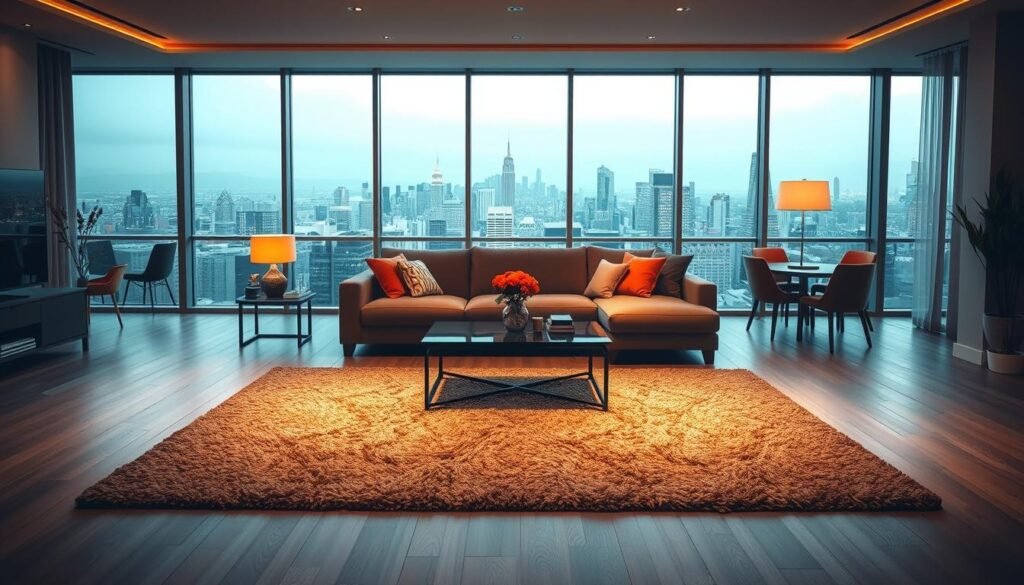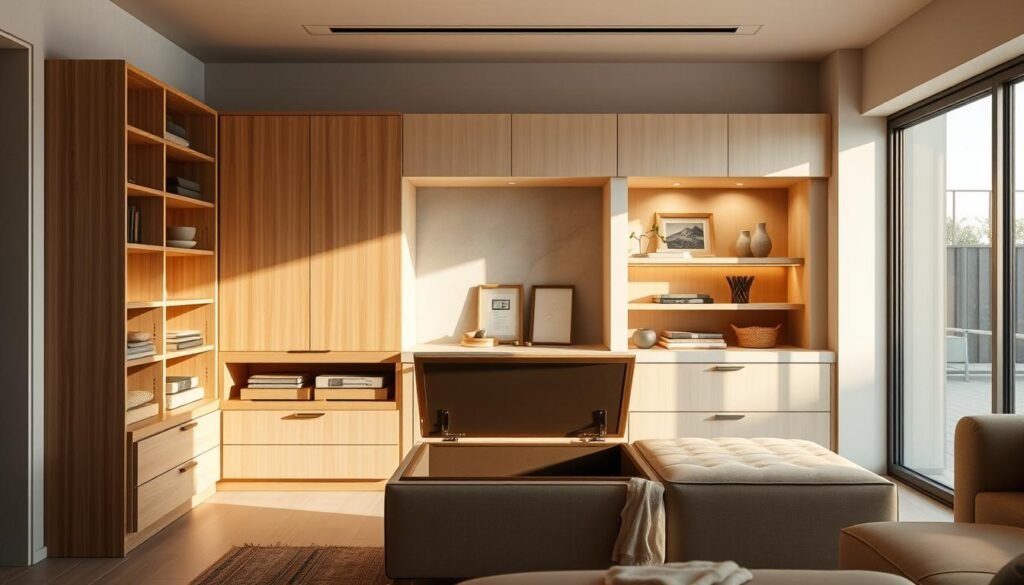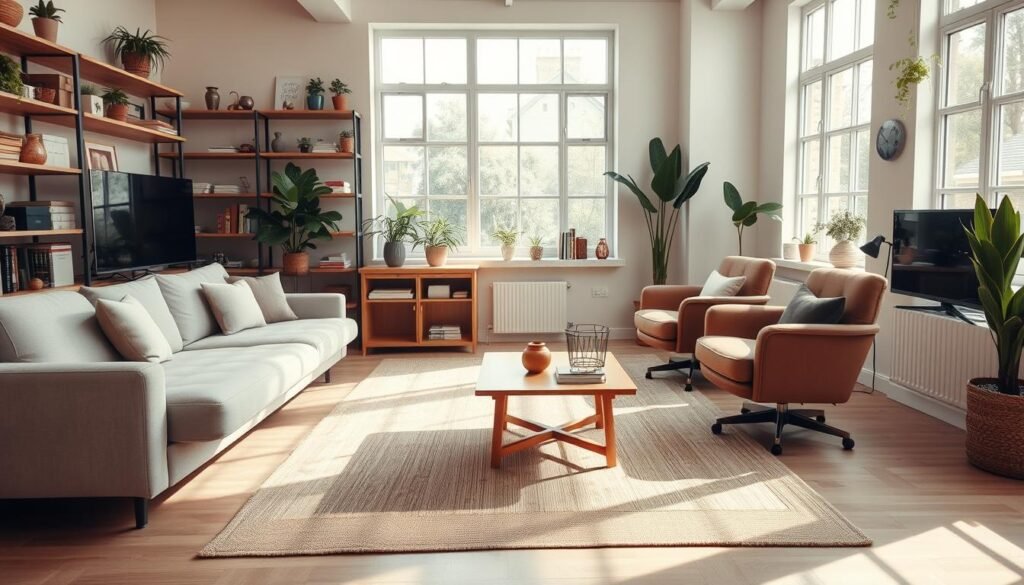Many of us live in homes that could benefit from smarter space planning. Limited square footage means every inch needs to work harder for your lifestyle.
A multi-use space serves more than one function beautifully. It transforms traditional single-purpose rooms into flexible areas that adapt to your daily needs.
This guide shows you how to maximize your living area without expensive renovations. You’ll discover professional strategies that blend style with functionality.
Learn to create dedicated zones for different activities without physical walls. Smart furniture choices and innovative storage solutions make it all possible.
Key Takeaways
- Transform any room into versatile spaces that serve multiple purposes
- Maximize your square footage without construction or major renovations
- Implement clever zoning techniques to define different activity areas
- Choose furniture that offers both style and smart storage solutions
- Create organized, clutter-free environments that support daily routines
- Blend work, relaxation, and entertainment functions seamlessly
- Adapt traditional room designs to modern flexible living needs
Why Your Home Needs to Be Multifunctional
Your living environment must keep pace with today’s dynamic lifestyle. As remote work and flexible schedules become standard, your house serves more roles than ever before.
Modern life demands spaces that adapt throughout your day. You might need a quiet area for focused work, then quickly transform that same spot for family movie night.
Urban dwellers especially understand space limitations. Not everyone can dedicate separate rooms for every activity. Your living room might host both workouts and relaxation.
Versatile design lets you maximize every square foot. You create dedicated zones for different activities without permanent walls. This approach makes smaller properties work efficiently.
Imagine your kitchen serving as both cooking space and occasional office nook. Your guest room could transform into a productive home office when visitors aren’t present.
Multifunctional spaces accommodate various family members simultaneously. Children can play while adults work nearby. Everyone enjoys their preferred activities without crowding.
This design philosophy brings economic benefits too. You avoid expensive expansions by making existing areas work smarter. Your property’s value and appeal increase through clever organization.
Interior designers regularly transform single-purpose rooms into versatile areas. They create environments that serve two or three key functions beautifully. The result is daily life that flows more smoothly.
Dedicated spaces boost both productivity and relaxation. You’ll appreciate having proper work areas instead of taking Zoom calls from your sofa. Everything feels more organized and intentional.
Your home becomes a true reflection of how you actually live. It supports work, family time, entertainment, and rest without compromise. This adaptability makes daily routines more enjoyable and efficient.
Master the Art of Zoning Your Space
The magic of modern living lies in creating purposeful zones within open spaces. You can transform one large room into several functional areas without construction.
This approach makes your home work smarter for your daily routine. Each zone serves a specific purpose while maintaining visual harmony.
Use Color and Rugs to Define Areas
Color creates instant visual separation between different activity areas. Paint one wall section a different shade to mark a transition between spaces.
Area rugs perform the job of walls without blocking light or movement. Choose a rug that fits comfortably under your lounge furniture to define relaxation spaces.
Coordinating decor items around each rug strengthens the boundary effect. Your workspace gains its own identity through color-matched accessories.

Arrange Furniture to Create Natural Flow
Large furniture pieces become anchors that organize your room. Position sofas and dining tables according to how you want movement to flow.
Open bookcases beautifully divide space without closing it off. They maintain an airy feeling while creating separate zones.
Your furniture arrangement should guide people naturally between areas. This creates intuitive pathways for daily activities.
Layer Lighting to Enhance Different Zones
Lighting plays a crucial role in defining various functional areas. Use spotlights in kitchen zones for bright, focused illumination.
Pendant lights work perfectly over dining spaces for ambient glow. Softer table and floor lamps create cozy atmospheres in living areas.
Each zone deserves its own lighting strategy. This layered approach helps you mentally transition between activities throughout your day.
Professional interior designers often use these techniques in multipurpose rooms. They combine area rugs, furniture groupings, and strategic lighting instead of physical walls.
Your home becomes more organized and adaptable through smart zoning. You’ll enjoy clearer separation between work, relaxation, and entertainment spaces.
Choose Smart, Multifunctional Furniture Pieces
Innovative furniture designs revolutionize how you utilize every square foot. The right pieces serve multiple functions without compromising style or comfort.
These versatile furnishings adapt to your changing needs throughout the day. You gain flexibility without sacrificing aesthetic appeal.
Select Pieces That Serve Dual Purposes
Look for furniture that performs double duty in your living space. An ottoman with hidden storage works as both seating and organization solution.
The Taylor Console Desk serves as workspace, sideboard, or dressing table. This adaptability makes it perfect for smaller homes.
Consider the Halo Wood Coffee Table with its rotating top design. It provides hidden storage for remote controls and daily essentials.
Convertible options like sofa beds offer guest accommodation when needed. They transform living areas into comfortable sleeping spaces overnight.
Extendable tables accommodate both working and dining needs beautifully. They adjust to different activities throughout your day.
Prioritize Scale and Mobility
Avoid oversized pieces that dominate your room’s layout. Choose smaller furnishings that provide comfort without overwhelming the space.
Mobile furniture allows you to reconfigure areas based on current needs. You can easily shift from entertaining guests to focused work sessions.
Stacking tables and fold-down computer desks maximize functionality. They tuck away when not in use, freeing up valuable floor space.
Drop-leaf tables expand for dining then contract for daily use. This flexibility makes them ideal for multipurpose rooms.
Lightweight pieces with wheels or casters offer maximum adaptability. You can quickly rearrange your space for different activities.
Designers recommend furnishings that can be easily moved around. This approach lets you customize room use based on your schedule.
Your furniture should work with your lifestyle, not against it. Smart choices create environments that support how you actually live.
Implement Clever Storage Solutions
Smart storage transforms cluttered rooms into organized spaces that work efficiently. Your multifunctional areas stay tidy and ready for any activity with the right solutions.

Utilize Stylish Built-in and Freestanding Storage
Beautiful storage pieces add function without sacrificing style. The Scandi-inspired Trua Oak Large Sideboard offers ample space for dining essentials or office supplies.
Freestanding options like the Milly Bookcase provide extra built-in cupboards. These pieces keep your room organized while enhancing your interior design.
Large shelving units handle books, records, and decorative items beautifully. They create dedicated homes for your belongings while maintaining visual appeal.
Incorporate Hidden Storage Hacks
Creative solutions make everyday items disappear when not needed. Storage footstools hide magazines and remote controls inside their hollow bases.
Pretty baskets stash throws and cushions out of sight. This approach keeps your space tidy while maintaining aesthetic charm.
Kitchens that double as work areas benefit from special hacks. Install easy-to-access bins behind doors or inside drawers for laptops and paperwork.
Add small slots underneath island countertops to tuck away charger cables during meal preparation. This keeps cooking surfaces clear and safe.
The key is putting away items not required for your current task. This practice maintains both physical organization and mental clarity throughout your day.
Your storage solutions should work seamlessly with your room’s design. They become functional elements that contribute to your overall aesthetic while serving practical purposes.
Blur the Lines Between Indoor and Outdoor Living
Your home’s potential expands when you connect interior and exterior spaces. This approach creates a more open, airy feeling throughout your property.
Bifold doors transform how you experience your living environment. They flood rooms with natural light while creating seamless transitions between inside and outside.
These innovative doors slide completely away during warmer months. Your interior space suddenly gains an outdoor extension for entertaining.
Budget-conscious solutions deliver similar benefits without major renovations. Paint garden walls and fences using your interior color palette.
This simple trick creates visual continuity between spaces. Your outdoor area feels like a natural extension of your home’s design.
Extend tiles or wood flooring from your kitchen onto the patio. This technique makes both spaces appear larger and more connected.
Bring interior design elements outdoors to strengthen the connection. Hang waterproof pendant lights above your al fresco dining area.
Choose outdoor rugs that complement your interior decor. These touches create visual harmony between your indoor and outdoor spaces.
Well-designed connections reduce energy costs through increased natural light. Your home feels more spacious without permanent structural changes.
Professional designers use these techniques to create cohesive flow. Even small homes gain additional entertaining space during warmer months.
Essential Tips for Creating a Multifunctional Home
Your daily routine deserves a home that adapts seamlessly to changing needs. These professional strategies help you achieve both beauty and functionality in every room.
Focus on Two to Three Key Functions
Limit each area to primary activities that matter most to your family. This prevents your space from feeling chaotic or overwhelming.
Identify what you truly need from each room before planning layouts. Your living area might serve entertainment and relaxation, while a guest room could double as an office.
Professional designers follow this golden rule for successful multipurpose spaces. They create environments that support specific activities without compromise.
“A well-designed room serves its primary purposes beautifully without trying to do everything at once.”
This approach ensures each zone feels intentional and organized. You’ll enjoy clearer separation between work, family time, and relaxation.
Opt for a Timeless, Neutral Foundation
Neutral color palettes provide design longevity that adapts to changing needs. They create calming backdrops for various activities throughout your day.
Your home office benefits from focused simplicity, while play areas maintain visual tranquility. Classic furnishings offer flexibility for future rearrangements.
White walls serve as perfect canvases for personal expression through accessories. Artwork and patterned fabrics add character without permanent commitments.
Seasonal decorating becomes effortless with neutral foundations. Swap pillows and throws to refresh colors and patterns without major redesign efforts.
This approach saves time and money while maintaining design coherence. Your space evolves with your tastes over years rather than months.
Incorporate a Variety of Lighting Sources
Lighting transforms how you experience and utilize every corner of your home. Multiple sources let you adjust ambiance for different activities and moods.
Dimmable overhead lights provide flexibility throughout your day. They brighten for morning tasks and soften for evening relaxation.
Wall sconces and floor lamps create atmospheric lighting for entertainment. Table lamps offer softer illumination for reading or television watching.
Task lighting ensures proper illumination for specific activities. Desk lamps support focused work in office zones. Picture lights highlight artwork throughout your space.
Interior designers recommend layered lighting for multipurpose rooms. This approach lets you customize environments based on current needs.
Your home becomes more adaptable through thoughtful illumination choices. Each activity receives appropriate lighting support throughout your daily routine.
Conclusion
The journey to a more adaptable living area starts with identifying your most essential activities and needs. Remember that strategic zoning creates visual separation without physical walls, using color, rugs, and smart furniture placement.
Multifunctional furniture pieces serve multiple purposes while maintaining style. Clever storage solutions keep your spaces organized across different functions. Connecting indoor and outdoor areas expands your living space beautifully.
Focus on two to three main functions per room. Use neutral foundations and layered lighting for flexibility. Your home can evolve with changing needs through thoughtful design choices.
Anyone can create spaces that serve multiple purposes while maintaining comfort and style. Start with what matters most to your daily routine and build from there.


